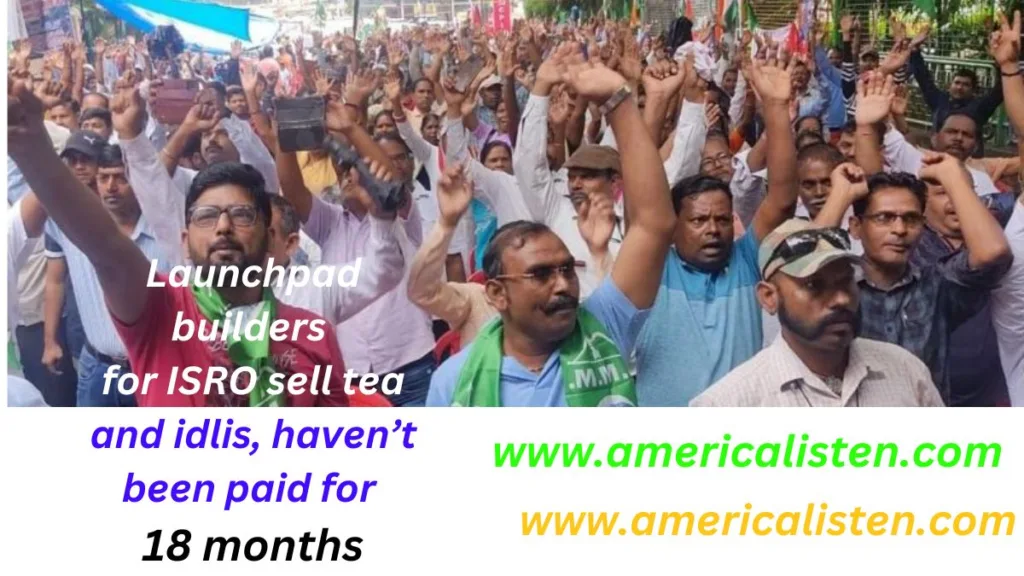While India celebrated the historic achievement of Chandrayaan-3 making a soft landing on the Moon’s South Pole, a different tale unfolds on the ground. Thousands of dedicated launch pad workers, who played a crucial role in this achievement, are grappling with a harsh reality – they haven’t received their salaries for the past 18 months. The dreams of landing on the Moon have come true, but the struggle of these workers remains unanswered.
1. Chandrayaan-3 is India’s upcoming lunar exploration mission, following the success of Chandrayaan-3
2.The mission aims to further explore the Moon, with a focus on the south polar region.
3.Chandrayaan-3 is expected to carry advanced instruments to enhance scientific discoveries and build on the achievements of its predecessor missions.

Chandrayaan-3: India’s Remarkable Feat
Chandrayaan-3’s successful soft landing on the Moon’s South Pole marked a significant milestone for India, making it the first country to achieve this remarkable feat. The entire nation celebrated this scientific triumph.
Prime Minister Narendra Modi, while in South Africa for the BRICS summit at the time of the landing, addressed ISRO scientists and the nation from Johannesburg. He was lauded for the mission’s success, highlighting the significance of this momentous event.

Workers’ Protest Amidst Celebration
Ironically, as Prime Minister Modi praised ISRO’s success in Johannesburg, launch pad workers of Chandrayaan were back home in Dhurwa, Ranchi, protesting for their unpaid salaries spanning 18 months. These workers, totaling 2,800 employees of the Heavy Engineering Corporation Limited (HEC), are still awaiting their rightful dues.
HEC’s Role in Chandrayaan and ISRO
HEC, a Government of India Company (CPSU), has been a crucial player in India’s space endeavors. Beyond the 810-ton launchpad, HEC has fabricated essential components like the folding platform WBS and sliding doors for Chandrayaan. Furthermore, HEC is currently engaged in constructing another launchpad for ISRO.
Making Ends Meet: Stories of Struggling Workers
The plight of these dedicated workers is exemplified by Deepak Kumar Upararia, a technician at HEC, who, for the past few days, has been selling idlis to make ends meet. Deepak operates a small shop in Dhurwa, selling idlis in the morning, attending work in the afternoon, and returning to sell idlis in the evening to sustain his family.
Speaking to the BBC, Deepak shared his struggles, including accumulating debts, mortgaging his wife’s jewelry, and facing the emotional toll of seeing his children humiliated at school due to unpaid fees.
This predicament extends beyond Deepak Upararia. Several HEC employees are now engaged in alternative livelihoods to make ends meet. For instance, Madhur Kumar sells momos, Prasanna Bhoi sells tea, and Subhash Kumar faces bank default on a car loan. The cumulative impact affects over 14,000 people, including the families of HEC workers.
HEC’s Financial Woes
HEC has faced severe financial challenges, reporting continuous losses over the last five years. The company’s liabilities have mounted to approximately Rs. 2,000 crore. Despite having significant orders from organizations like ISRO, BARC, and DRDO, the lack of working capital has hindered their completion.
The Struggle for Survival
The workers at HEC are caught in a relentless cycle of uncertainty due to multiple factors. The absence of a permanent CMD or directors for four years, outdated machinery, and insufficient orders have compounded their woes. The HEC Officers Association has sought government intervention and a subsidy of Rs. 3,000 crore to revive the company.
Despite efforts by local MPs and leaders, the central government has not provided substantial assistance to HEC. The fate of this institution, founded by Pandit Nehru, hangs in the balance as it struggles for survival in the face of central government policies and privatization attempts.
Conclusion
While India celebrates its space achievements on the global stage, the forgotten heroes of these missions, the HEC workers, continue to face dire circumstances. Their dedication and contributions to India’s space endeavors cannot be understated. It is crucial for the government to step in and ensure these workers receive their long-overdue salaries and safeguard the future of this institution, preserving its legacy for generations to come.

Unhappy People
The perception that the Modi government is favoring wealthy individuals or corporations over lower-class government employees is a subject of debate and criticism. It’s important to note that government policies and decisions often involve complex factors, and perspectives on these matters can vary widely. Here are some points to consider:
Economic Policies: The Modi government has implemented various economic policies aimed at promoting economic growth and development. This includes initiatives to attract investments from both domestic and foreign sources. While such policies may benefit large corporations, their proponents argue that a thriving economy can create jobs and generate wealth that can eventually benefit all segments of society.
Job Creation: The government has also launched several programs and initiatives with the goal of job creation. These efforts are designed to provide employment opportunities for individuals across different income levels. However, the effectiveness and impact of these programs can vary.
Social Welfare Programs: The Modi government has introduced various social welfare programs, such as Jan Dhan Yojana, Pradhan Mantri Awas Yojana, and Ayushman Bharat, which are targeted at providing financial inclusion, housing, and healthcare to economically disadvantaged citizens.
Criticism and Debate: Critics argue that the government should do more to address the concerns of lower-class government employees, including salary issues and job security. They contend that the government should prioritize the welfare of its employees, as they play a crucial role in public service delivery.
Economic Disparities: India is a country with significant income disparities, and addressing these disparities is a complex challenge. Government policies often aim to strike a balance between fostering economic growth and addressing social inequalities.
Public Opinion: Public opinion on these matters can be diverse and influenced by political affiliations, economic circumstances, and personal experiences. Different segments of society may have different perspectives on government policies and their impact.
Ultimately, the question of whether the Modi government is favoring millionaires like Adani over lower-class government employees is subjective and may depend on one’s perspective. It’s essential for any government to consider the needs and concerns of all its citizens and strike a balance between economic development and social welfare. Public discourse, constructive criticism, and political accountability play a crucial role in shaping government policies and decisions.
The perception that the Modi government is favoring wealthy individuals or corporations over lower-class government employees is a subject of debate and criticism. It’s important to note that government policies and decisions often involve complex factors, and perspectives on these matters can vary widely. Here are some points to consider:
Economic Policies: The Modi government has implemented various economic policies aimed at promoting economic growth and development. This includes initiatives to attract investments from both domestic and foreign sources. While such policies may benefit large corporations, their proponents argue that a thriving economy can create jobs and generate wealth that can eventually benefit all segments of society.
Job Creation: The government has also launched several programs and initiatives with the goal of job creation. These efforts are designed to provide employment opportunities for individuals across different income levels. However, the effectiveness and impact of these programs can vary.
Social Welfare Programs: The Modi government has introduced various social welfare programs, such as Jan Dhan Yojana, Pradhan Mantri Awas Yojana, and Ayushman Bharat, which are targeted at providing financial inclusion, housing, and healthcare to economically disadvantaged citizens.
Criticism and Debate: Critics argue that the government should do more to address the concerns of lower-class government employees, including salary issues and job security. They contend that the government should prioritize the welfare of its employees, as they play a crucial role in public service delivery.
Economic Disparities: India is a country with significant income disparities, and addressing these disparities is a complex challenge. Government policies often aim to strike a balance between fostering economic growth and addressing social inequalities.
Public Opinion: Public opinion on these matters can be diverse and influenced by political affiliations, economic circumstances, and personal experiences. Different segments of society may have different perspectives on government policies and their impact.
Ultimately, the question of whether the Modi government is favoring millionaires like Adani over lower-class government employees is subjective and may depend on one’s perspective. It’s essential for any government to consider the needs and concerns of all its citizens and strike a balance between economic development and social welfare. Public discourse, constructive criticism, and political accountability play a crucial role in shaping government policies and decisions.
1.It seems there’s a slight inconsistency in the statement you provided, as it mentions both “Chandrayaan-3” and “Chandrayaan-3.” Assuming you intended to refer to Chandrayaan-2 and Chandrayaan-3, here’s a discussion:
Chandrayaan-3 is India’s highly anticipated lunar exploration mission, succeeding the successful Chandrayaan-2 venture. Building on the achievements and lessons learned from Chandrayaan-2, which included the historic soft landing of the Vikram lander and the deployment of the Pragyan rover on the lunar surface, Chandrayaan-3 aims to further advance India’s lunar exploration efforts. Expected to incorporate improved technology and scientific instruments, the mission will continue the exploration of the Moon, with a specific emphasis on the south polar region, where water ice has been detected in previous missions. Chandrayaan-3 holds the promise of contributing valuable data to enhance our understanding of the Moon’s geology and unlock new insights into lunar science.
2.Indeed, Chandrayaan-3’s primary objective is to advance lunar exploration by concentrating on the Moon’s south polar region. This specific focus is driven by the scientific significance of the area, where previous missions, including Chandrayaan-2 and other international endeavors, have identified the presence of water ice. The exploration of the south polar region is crucial for understanding lunar geology, potential resources, and contributing to broader scientific knowledge about Earth’s celestial neighbor. Chandrayaan-3’s targeted approach underscores India’s commitment to advancing space exploration and unraveling the mysteries of the Moon.
3.Chandrayaan-3 is anticipated to be equipped with state-of-the-art instruments designed to elevate scientific exploration and build upon the successes of its predecessors. The mission aims to deploy advanced technologies to further enhance our understanding of the Moon’s geological composition, surface characteristics, and potential resources. By leveraging improved scientific instruments, Chandrayaan-3 aspires to contribute valuable data that will deepen human knowledge about the Moon and pave the way for future lunar exploration endeavors. The mission reflects India’s commitment to pushing the boundaries of space exploration and fostering advancements in lunar science.
To know more about Chandrayaan-3 please click here
You May like :
Best Winter Dish: Dry Fish,Uses Medical Benefits Recipes and Side Effects


